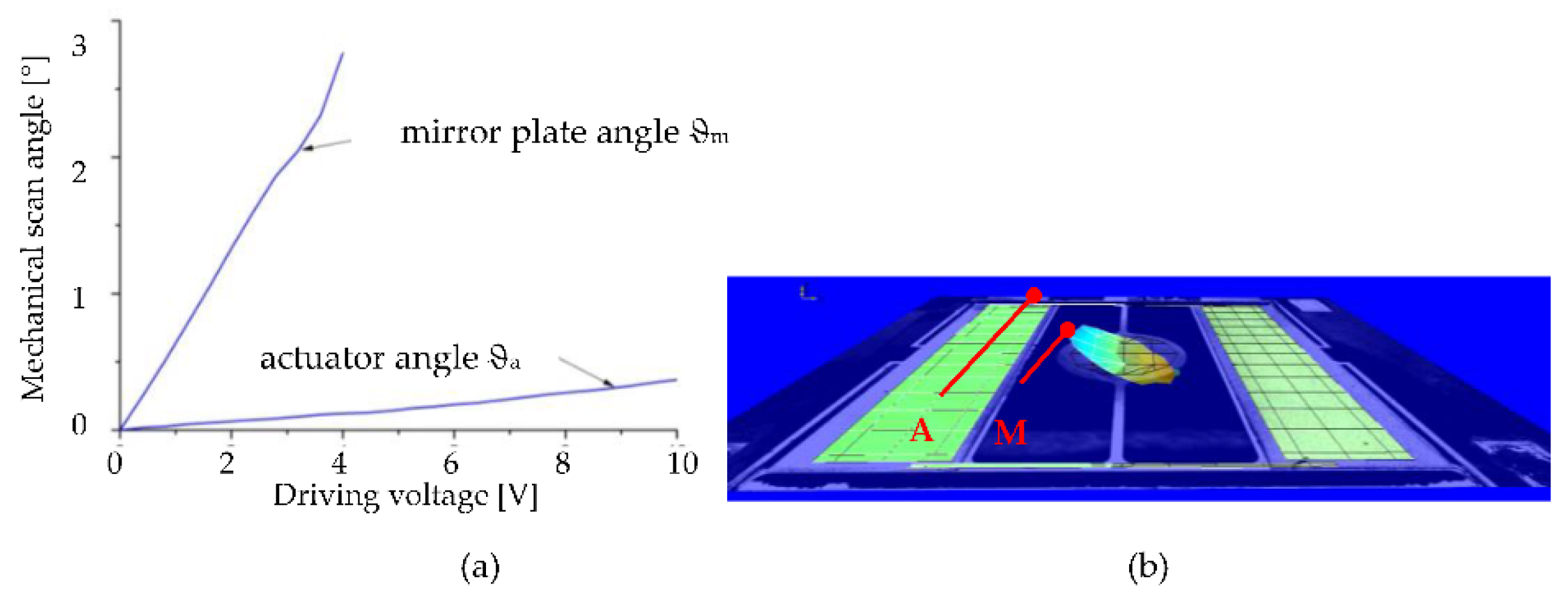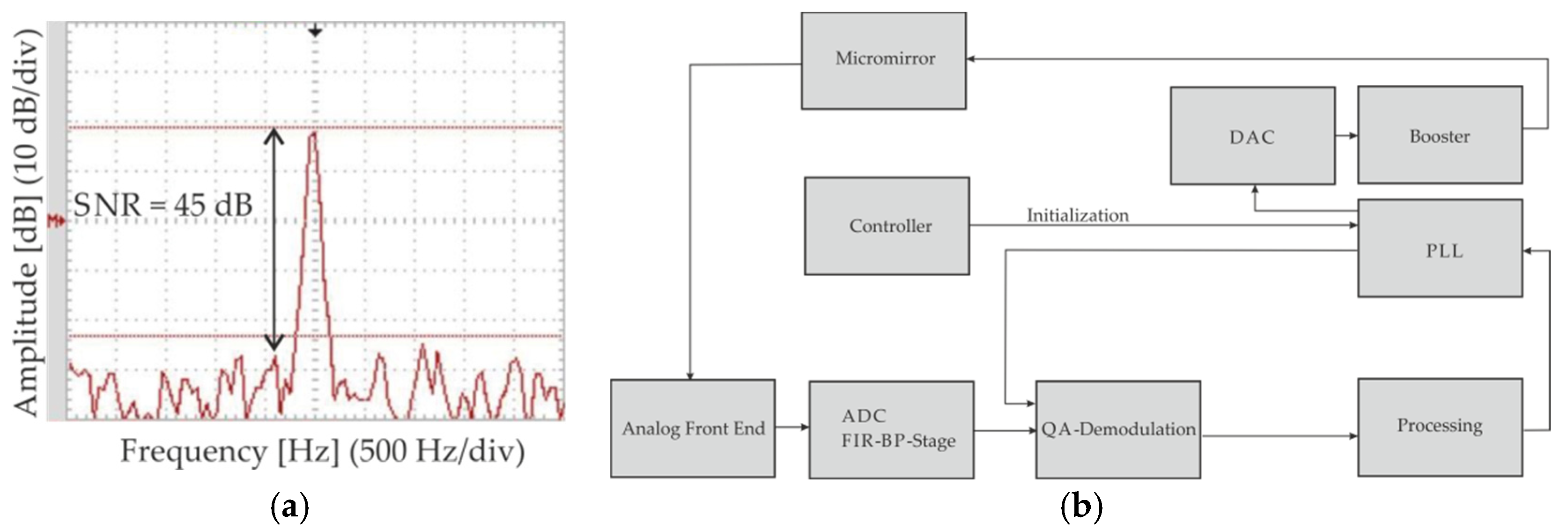Piezoelectrically Driven and Sensed Micromirrors with Extremely Large Scan Angles and Precise Closed-Loop Control †
Abstract
:1. Introduction
2. Design, FEM Simulation and Fabrication
2.1. Basic Design
2.2. Fracture Behavior and Design Optimization
3. Measurement Results
4. Outlook and Discussion
Conflicts of Interest
References
- Gu-Stoppel, S.; Kaden, D.; Quenzer, H.J.; Hofmann, U.; Benecke, W. High speed piezoelectric microscanners with large deflection using mechanical leverage amplification. In Proceedings of the 26th European Conference on Solid-State Transducers (EUROSENSOR), Krakow, Poland, 9–12 September 2012; pp. 56–59. [Google Scholar]
- Gu-Stoppel, S.; Janes, J.; Quenzer, H.J.; Hofmann, U.; Kaden, D.; Wagner, B.; Benecke, W. Design, fabrication and characterization of low-voltage piezoelectric two-axis gimbal-less microscanners. In Proceedings of the 2013 Transducers Eurosensors XXVII: The 17th International Conference on Solid-State Sensors, Actuators and Microsystems (TRANSDUCERS EUROSENSORS XXVII), Barcelona, Spain, 16–20 June 2013; pp. 2489–2492. [Google Scholar]
- Rombach, S.; Marx, M.; Gu-Stoppel, S.; Manoli, Y. Low power and highly precise closed-loop driving circuits for piezoelectric micromirrors with embedded capacitive position sensors. In Proceedings of the SPIE 9760 MOEMS Miniaturized Systems XV, 97600Q, San Francisco, CA, USA, 13 February 2016; Volume 9760. [Google Scholar]
- Zhang, C.; Zhang, G.; You, Z. A two-dimensional micro scanner integrated with a piezoelectric actuator and piezoresistors. Sensors 2009, 9, 631–644. [Google Scholar] [CrossRef] [PubMed]
- Gu-Stoppel, S. Entwicklung, Herstellung und Charakterisierung Piezoelektrischer Mikrospiegel; BoD—Books on Demand: Hamburg, Germany, 2016. [Google Scholar]





| Design | Aperture Diameter [mm] | Driving Voltage [V] | Full Optical Scan Angle [°] | Simulated Frequency [kHz] | Measured Frequency [kHz] | Power Consumption [mW] | Q-Factor |
|---|---|---|---|---|---|---|---|
| S | 1 | 22 | 106.3 | 47.1 | 45.1 | 10.3 | 5149 |
| E4 | 1.2 | 25 | 86.7 | 28.1 | 26.8 | 13.5 | - |
| E5 | 1.2 | 20 | 104.2 | 34.1 | 31.2 | 5.8 | - |
Publisher’s Note: MDPI stays neutral with regard to jurisdictional claims in published maps and institutional affiliations. |
© 2017 by the authors. Licensee MDPI, Basel, Switzerland. This article is an open access article distributed under the terms and conditions of the Creative Commons Attribution (CC BY) license (https://creativecommons.org/licenses/by/4.0/).
Share and Cite
Gu-Stoppel, S.; Giese, T.; Quenzer, H.-J.; Hofmann, U.; Benecke, W. Piezoelectrically Driven and Sensed Micromirrors with Extremely Large Scan Angles and Precise Closed-Loop Control. Proceedings 2017, 1, 561. https://doi.org/10.3390/proceedings1040561
Gu-Stoppel S, Giese T, Quenzer H-J, Hofmann U, Benecke W. Piezoelectrically Driven and Sensed Micromirrors with Extremely Large Scan Angles and Precise Closed-Loop Control. Proceedings. 2017; 1(4):561. https://doi.org/10.3390/proceedings1040561
Chicago/Turabian StyleGu-Stoppel, Shanshan, Thorsten Giese, Hans-Joachim Quenzer, Ulrich Hofmann, and Wolfgang Benecke. 2017. "Piezoelectrically Driven and Sensed Micromirrors with Extremely Large Scan Angles and Precise Closed-Loop Control" Proceedings 1, no. 4: 561. https://doi.org/10.3390/proceedings1040561
APA StyleGu-Stoppel, S., Giese, T., Quenzer, H.-J., Hofmann, U., & Benecke, W. (2017). Piezoelectrically Driven and Sensed Micromirrors with Extremely Large Scan Angles and Precise Closed-Loop Control. Proceedings, 1(4), 561. https://doi.org/10.3390/proceedings1040561




